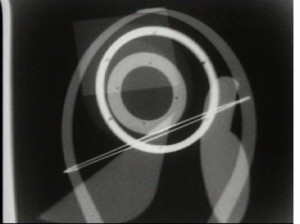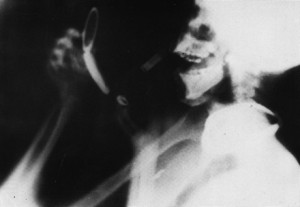Click here to print
Blood, Guts, Gore – and More
posted May 4, 2010
By Peter Monaghan
 A still from Qualia Diaries, directed by Emily Mode; courtesy Emily Mode.
A still from Qualia Diaries, directed by Emily Mode; courtesy Emily Mode.

Film buffs who attended this year’s Medical Film Symposium, held over four days in January, may by now be able to sleep, and wake, without being haunted by the images they viewed there.
Some of the footage would rotate a corpse. Human Rabies (1929), for example, graphically documented the fate of four boys bitten by rabid dogs and then admitted to hospital too late to survive.
And then there were gelatinous images of eye surgery and the pustular ravages of venereal diseases, at which point you might have thought you were back in high-school health ed.
“Some of it was gruesome – the closeups of venereal diseases, for example. It was pretty shocking, there’s no way to get around that,” says Dwight Swanson, one of two organizers of the event, held in Philadelphia in collaboration with several film groups and medical institutions.
Swanson says he and fellow organizer Joanne Poses, a fellow film archivist with whom he founded Philadelphia’s Community Screen, wanted the symposium to involve members of three professions: film historians, medical historians, and film archivists, particularly the few medical-film specialists. “We wanted to bring everyone together, to start a dialog,” he says. “We heard from participants that they are somewhat isolated from each other, mostly because their fields are so small.”
The medical-film genre, as it happens, was one of the first in film history, although you could hardly be expected to know that, today. Thanks to both the subject matter and the history of the films shown, the symposium was equally rewarding for archivists and the merely curious. Swanson admits that he is among the latter: “Curiosity is a big apart of it,” he says. “I really was trying to understand what the films look like and how they function.”

X-rays by Dr. James Sibley Watson; from Sanctus, directed by Barbara Hammer; courtesy Barbara Hammer.
On show were shorts documenting medical procedures, training films for health professionals, and hygiene tutorials. Among the last category were several educational shorts shown during a session curated by Jay Schwartz, of the Secret Cinema, and Skip Elsheimer, from North Carolina’s A/V Geeks. They offered the likes of Feet and Posture, Achieving Sexual Maturity, and a perennial fave, Non-Syphilitic Venereal Disease.
Also on show at the symposium was medical imaging from the dawn of the x-ray to the most modern of snaking scopes. Images in the latter category can prove all the more palatable for being less graphic and more abstract than some of the earliest, breathtaking surgery footage; some – colonoscopies, for example – can also be at least as diverting as much that you’re likely to see during an average evening of tv viewing.
Certainly you can’t miss with a short constructed from footage from a medical procedure where blasting from a operating-room radio comes Peter Gabriel’s timeless “Sledge Hammer” – “open up your fruitcage / where the fruit is as sweet as can be…” Add to that a later voice-over of the patient singing along, and you have a sure-fire festival winner, at once rollicking and bracing: Brina Thurston’s Colon Karaoke (2008).
The range of films shown at the symposium illustrated how disparate, and fascinating, the genre can be. On display, for example, were Depression-era, poverty-row director Edgar G. Ulmer’s shorts for the National Tuberculosis Association and Bell Labs’ innovations for high-speed cinematography and laryngoscopy. Particularly well-received was an evening of multimedia projections at the country’s oldest hospital, Pennsylvania Hospital. Andrew Lampert, a New York artist, filmmaker, and archivist, and Greg Pierce, curator of Pittsburgh’s Orgone Archive, were able to borrow the apt but forbidding environs of the hospital’s historic surgical amphitheater, where demonstration operations were first performed in the late 19th century.
While many films screened during the weekend were of a documentary or public-information nature, work was also presented that demonstrated the little-tapped potential of medical-related film. Karen Aqua’s short, Twist of Fate (2009), for example, uses experimental animation and collage to deftly relate Aqua’s encounter with cancer. Barbara Hammer’s 2008, 30-minute contribution, A Horse is Not a Metaphor, uses multilayered images from her chemotherapy sessions and her imaginative escape into such scenery as Georgia O’Keefe’s Ghost Ranch in New Mexico, the foothills of the Big Horn in Wyoming, and leafy paths in Woodstock, New York. Emily Mode’s 2009 Qualia Diaries is based on Mode’s diagnosis with a seizure disorder, which she explores through such perspectives as her childhood foreshadowings of the illness.
Of course, Hollywood has frequently embraced illness as a dramatic medium, too. Exemplifying that history was Garson Kanin’s 1938 confrontational 80-minute feature, A Man To Remember, which alerts viewers of today that the shortcomings of modern-day American health care continue a long tradition of neglect. In the Depression-era screed, written by Dalton Trumbo and infused with folksie anti-establishment fervor, a local doctor opposes evil powerbroker’s to protect the public health during an impending polio epidemic.
Like medical-film archivists, medical films can be hard to come by. One benefit of a symposium like his and Poses’, says Swanson, is that it spares researchers the trouble of traveling to distant archives, only to have to watch access copies on small screens. “It’s so rare that they’d be projected, and many never were intended to be seen by general audiences as opposed to people at medical schools,” he explains.
Garson Kanin’s A Man To Remember alerts viewers of today that the shortcomings of modern-day American health care continue a long tradition of neglect
Not surprisingly, then, research on the films has been scant. “There’s no one book out there,” says Swanson. “You really have to search through obscure old journals to find any information at all.”
If you can stand the blood, guts, and gore. Swanson, not too proud to admit to some squeamishness, says: “A lot of the films were really difficult for a lay person to watch, so I wanted to come to terms with that in my own mind – to ask, what makes them interesting.”
With any luck, subsequent gatherings will permit more viewers to ask themselves that question, too.
Printed from Moving Image Archive News: https://www.movingimagearchivenews.org
URL to article: https://www.movingimagearchivenews.org/blood-guts-gore-%e2%80%93-and-more/
Click here to print
